 Submitted by ANTARA - Manager on
Submitted by ANTARA - Manager on

To come face to face with one’s doppelgӓnger or double is a rare but chilling experience. The German poet Goethe (1749-1832) once met “himself” coming towards him up a garden path; according to European folklore this should have been a sign of imminent death, but Goethe lived for some years after the experience.
The doppelgӓnger, or in Victorian terms the ‘fetch’, is always said to be indistinguishable from the real person and is apparently solid looking. However, much more common in the archives of psychical research is the ghostly double or ‘wraith’, sometimes called the ka by occultists. This is believed to be attached to the physical body by an invisible chord that can stretch to accommodate astral travel during sleep and that snaps at death.
In 1835 the American writer Robert Dale Owen paused while in London to hear a story told by a young German woman, Julie von Güldenstubbe, that was to become a classic of its kind. It was the apparently well documented story of a doppelgӓnger . The ‘double’ or ‘fetch’ in this story stayed out of sight of its victim but never-the-less it evoked widespread terror. This ‘fetch’ was that of a French Schoolmistress Mademoiselle Emilie Sagée and it was seen not only by the young woman telling the story but also by over 40 of her companions at the Pensionat von Neuwelcke School.
It is said that one day, while teaching a class, Sagée's double appeared right next to her and mimicked her every move as she wrote on the chalkboard in full view of 13 students. Although others could see the double, Sagee never noticed the double nor did she notice that own movements slowed when the double appeared.
Sagée's double also appeared away from her and did not always mirror her movements. In another instance, the entire student body of 42 girls assembled in the school hall for their sewing and embroidery lessons. The double appeared in Sagée's chair while Sagée could be seen outside in the garden. Two of the girls attempted to touch the phantom Sagée but felt an odd resistance to her. One of the girls stepped between the chair and table and passed right through the phantom, which remained motionless and then disappeared.
It was said that Sagée's double would appear when she was worried or immersed in her work. It was said the double could also appear in a place Sagée was thinking about, like in the case above where she was in the garden; she looked inside at her chair and thought to herself that without supervision, the students may waste time and gossip.
How did the school react to the events? All the pupils, to some degree, had witnessed the phenomena; so Emilie, unwittingly, caused considerable commotion at Neuwelcke. Although she was very popular among the girls, the more timid gradually became disturbed by her presence. They told their parents, and the school directors noted with growing concern that fewer and fewer girls returned to the school at the beginning of each term. The reasons they gave were varied but it was generally accepted that the ‘double’ was the true reason. There was a temptation to dismiss Mlle Sagée but she was a perfectly good teacher and seemed to be the innocent victim of something beyond her control. Further, it would create a scandal to dismiss such an excellent teacher based on what seemed like grounds for insanity.
The school’s hopes for returned normalcy were all in vain and the population continued to dwindle. What became revealed was that Emilie, who had begun teaching at age 16, had been previously dismissed from 19 teaching posts because of two ‘Emilies.’
How does the Emilie Sagée case fit into contemporary knowledge? It is possible to discount the traditional anecdotes of astral projection or out-of-body experiences. All such cases imply an effort of will to ‘project’ the subject or some sort of perception while ‘out-of-body.’ In Emilie’s case there is no evidence that she ever projected her ‘fetch’ of her own volition or that she recorded any sensations while ‘in’ her double. Illusion, mass hysteria, and hallucination have also all but been ruled out. The truth of what happened will never be known.
“Seeing is believing.”
Resources:
Me and My Shadow by Colin Goodman, Mysteries of Mind, Space and Time, Vol.21
http://www.historiesmysteriesandstrangeness.com/2013/08/the-doppelganger-of-emilie-sagee.html